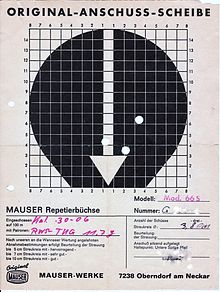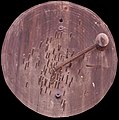Target
Shooting targets or targets are targets used by shooters . With the exception of the honor discs (see below), they are used to check the shooting skills of a shooter or the accuracy and accuracy of a firearm. In sport shooting, they are made of thin cardboard . Colloquially, they are often called shooting cards , cards or targets . The arrangement of the rings on a target is called a mirror or target mirror . The mirror consists of ten numbered rings one inside the other. A hit on the innermost ring is given the highest rating (10 rings). With historical targets, the target is often marked in black, from which the phrase: hit the mark , derives.
Connecting disc
Target targets are used to check the accuracy of a firearm as well as to aim in a firearm, the target and point of impact being brought into line with the help of a sight .
The 16-field disc is used to check the shot distribution in the shot sheaf.
Competition disc
Sport shooting
Depending on the discipline and distance in sport shooting, there are shooting targets in different sizes. The size of the target is regulated in the sports regulations of the shooting sports associations depending on the shooting discipline. Discs with a light background and black print are used.
In the case of targets for air rifle shooting at 10 meters, the “ten” has a diameter of 0.5 mm. When shooting at the same distance from the air pistol, the "ten" has a diameter of 11.5 mm and is divided into an inner and an outer ten. At 50 m, the ten is 10.4 mm, at 100 m 50 mm and at 300 m the ten has a diameter of 100 mm. Rings nine and ten are not labeled on the target at distances of 10 m and 50 m, with the exception of the pistol target.
The evaluation of hits on a target used to be done with the naked eye. Nowadays, an electronic evaluation machine is usually used for this, which can pull in different target sizes and evaluates the hits to within 1/100 mm. As a rule, only one shot per target may be fired for the evaluation (exception pistol: up to five shots).
In order to reduce the high paper consumption when shooting with the air rifle (a competition consists of 40 to 60 shots on 40 to 60 individual targets, which have to be changed after each shot), the use of strip targets with five to ten mirrors has been adopted. The strip targets can be used on the shooting range with a special target holder with the commercially available target pull systems.
Nowadays “electronic targets” are also used, which no longer require the target to be retrieved. These disks are displayed on a monitor, with the appearance familiar from cardboard disks. The shooter shoots a dark hole in a measuring frame, which forwards the result to an evaluation computer for display with an accuracy of 1/10 mm. This method is also used in the shooting competitions of the Olympic Games .
In the rifle language, a hit outside the target is jokingly referred to in Germany as a “ticket”, in Austria as a “fish”.
Shotgun shooting
In shotgun shooting, i. H. The sporty and hunting shooting with shot, machine-thrown small clay discs, throwing discs (formerly called clay pigeons ) are shot at. The tipping phase , a machine-drawn tin bunny whose segments tip over depending on the hit, is also a moving target in hunting shotgun shooting.
Archery
The origin of the target in 12th century England consisted of wagon wheels attached to a wooden support. You had to shoot in the hub. From this target wheel the target in darts developed. In archery , the term "target" today describes the surface on which the so-called "target pad" is attached. The disc usually consists of pressed straw or pressed paper with threads interwoven with it, and sometimes also of plastic. The target is then attached to this.
The target face in archery is made of printed paper. In principle, ten concentrically arranged zones (2 rings per color) are printed on the supports. It is colored, from the inside out, gold, red, blue, black and white. In field archery, only the center is gold, all other zones are black.
The size of the target depends on various factors:
- the type of bow ( bare bow , recurve bow , compound bow ),
- on the type of competition (hall or field) and associated with it
- on the distance (18m, 25m, 30m, 40m, 50m, 70m, 90m)
- and the age group (schoolchildren, youth, juniors, shooting class, age group, senior citizens)
This results in different sizes of the target face. According to the sports regulations of the DSB, there are requirements with a diameter of 40 cm, 60 cm, 80 cm and 122 cm as well as the 3-spot spot.
For example, a target face with a diameter of 122 cm is used by the women's shooting class with the recurve bow in the 70 m FITA lap outdoors. The disc is attached to a stand at an angle and the center of the disc is 1.30 meters above the floor.
Other German archery associations may have different target requirements.
Honor disc, historical shooting targets

The honor or king's disc is a traditional award for shooting competitions. The tradition is mainly widespread in the southern German-Austrian region and in Lower Saxony.
Honor discs are donated and shot in honor of a personality, on the occasion of a birthday, a wedding or a prize shooting. In Lower Saxony, king discs are awarded to the winner of the king's shooting as a prize and are often attached to the gable of his residence as a badge of honor .
Honor and royal discs are - and were especially in the 18th and 19th centuries - often artistically designed. The hand-painted wooden honor target is the original shape of the target.
The imposition of honor discs is often done covertly, i. H. with the target mirror taped shut, or the winner will be “knocked out” after shooting: blindfolded, a person stabs the target with a hunting knife and thus determines the target.
Honor disc from 1744 (Museum St. Veit an der Glan )
Target from 1722 (Museum St. Veit an der Glan )
Target from 1872 (1864 Schützen Wörth an der Donau )
Military discs
Targets are also used in the course of military training. In addition to shooting skills, decisive action should also be trained here. This means that shooting targets , colloquially “cardboard comrade” (a target with a human silhouette ) are also used. These are not to be confused with the honor marksmen's targets. They can also be inserted in a picture in a landscape. The design of the rifle targets can also provide information about the enemy image of a respective army. In Germany, the use of targets and targets that represent or symbolize people is not permitted in sport shooting.
Hunting discs
When shooting, both in competition and for hunting practice, images of hunted game species are usually shot at: chamois ( chamois ), deer, fox, wild boar ( defector ) - the latter also as a moving target ( running boar ). The arrangement of the rings follows the shape of the game and the desired location of the hit. Targets, which take better account of the anatomy of game, have not yet been able to gain acceptance.
Special forms
Targets with various other motifs can also be used when shooting for the title of a rifle king in shooting clubs or in "lucky shooting" (for example at Easter / Christmas).
Web links
- The history of the Schützenscheibe from the beginning
- Ulrike Götz: shooting target . In: RDK Labor (2020).
Individual evidence
- ^ Fritz Nüßlein : Jagdkunde. A textbook as an introduction to hunting . Bayerischer Landwirtschaftsverlag (BLV), Munich 1962 and 12 other editions, including the chapter rifle ammunition .
- ↑ German Shooting Federation (DSB), rule 0.4.3.01
- ↑ Arnd Krüger : The sport before the "English sport" in England and on the continent . In: Christian Becker, Cornelia Regin , Anton Weise (eds.): When sport came to Hanover. History and reception of a cultural transfer between England and Northern Germany from the 18th to the 20th century . Lit, Münster 2015, ISBN 978-3-643-13152-2 , pp. 36–54.
- ↑ Alfred Förg (Ed.): Schiess-Scheiben. Folk art through centuries . Rosenheimer Verlagshaus, Rosenheim 1976, ISBN 3-475-52167-9 .
- ↑ Chapter 1 a) 101. In: ZDv 3_136. Bundeswehr, accessed on December 16, 2010 .
- ↑ Appendix 2 Compilation of the target patterns 2 / 1-4. In: ZDv 3_136. Bundeswehr, December 16, 2010, accessed on August 13, 2019 .
- ^ NDR: Herlinde Koelbl - "Targets". Retrieved August 13, 2019 .
- ↑ § 15a (1). In: WaffG. Retrieved August 13, 2019 .
- ↑ Justice begins before the shot! In: Jäger in Schleswig-Holstein, p. 20. LJV Schleswig-Holstein, May 2010, accessed on August 13, 2019 .












